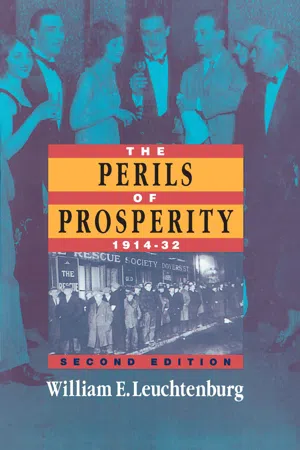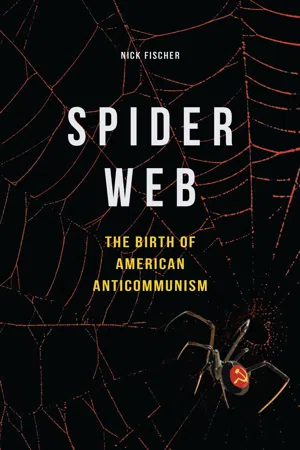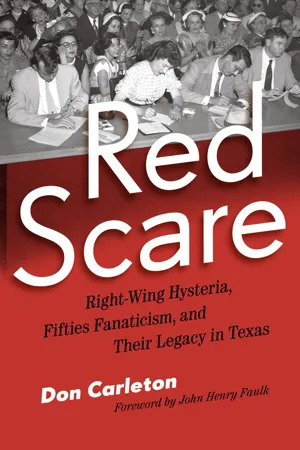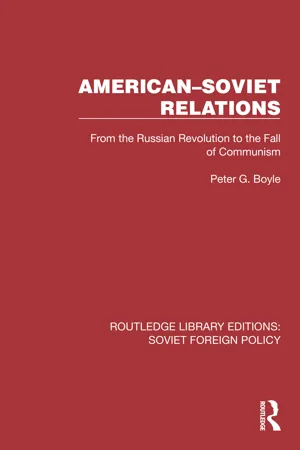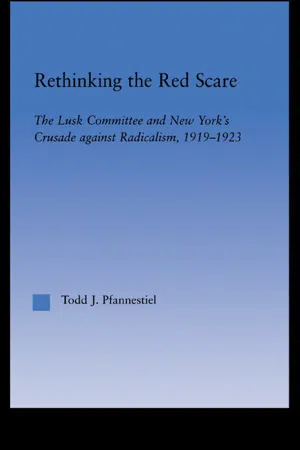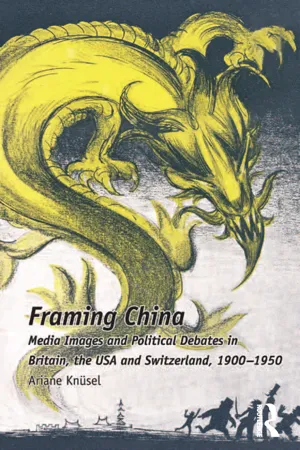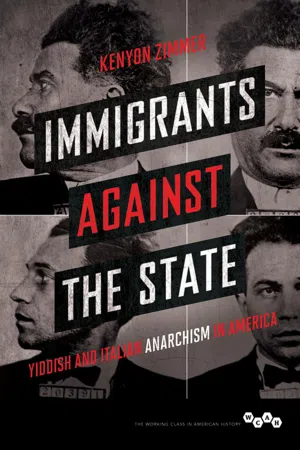History
Red Scare
The Red Scare refers to periods of intense anti-communist hysteria in the United States, particularly during the early 1920s and late 1940s to early 1950s. It was characterized by widespread fear of communist infiltration and led to government crackdowns on suspected communists, as well as the blacklisting of individuals in various industries.
Written by Perlego with AI-assistance
Related key terms
Related key terms
1 of 4
Related key terms
1 of 3
10 Key excerpts on "Red Scare"
- eBook - ePub
The Cold War at Home
The Red Scare in Pennsylvania, 1945-1960
- Philip Jenkins(Author)
- 2014(Publication Date)
- The University of North Carolina Press(Publisher)
4Red Scare Rampant, 1950–1953
We are a nation at war.... The force that is killing our loved ones, the power that is fighting against our democracy, is Communist, Godless Russia. It is fantastic to fight Communism with all our strength abroad, and to ignore it here at home.—State Senator Albert R. Pechan, 19531In retrospect, it seems remarkable that the suppression of a national political movement aroused so little opposition, but the virulence of anti-Communist feeling arose from general fears of a new world war in which American Communists might become an alien fifth column. The new Red Scare had its roots in events of the late 1930s, when the Roosevelt administration had exaggerated the threat of domestic traitors in order to make Americans more willing to confront the Axis powers, portraying native Fascist sympathizers as the allies of foreign intelligence services. Between 1938 and 1942, popular media often reported on the likely dangers of espionage and sabotage, and some genuine incidents of both did occur. In their struggles against Fascism and militarism, Americans were subjected to constant propaganda about the absolute evil of the Nazi and Japanese regimes, charges that had been confirmed by the exposure of the atrocities committed by those totalitarian states.2 The hatred stirred in the early 1940s was soon redirected against international Communism—Red Fascism—a menace made still more threatening by its capacity to devastate the American homeland with nuclear weapons.3This international context is essential to understanding the escalation of the Red Scare into a perceived threat of clandestine warfare on American soil. An official campaign to uncover potential enemy sympathizers did much to shape public attitudes to domestic Communism, and the anti-Communist movement was repeatedly galvanized by the events of this underground war. The appearance of FBI - eBook - ePub
- William E. Leuchtenburg(Author)
- 2010(Publication Date)
- University of Chicago Press(Publisher)
4Red Scare
In the year 1919, Senator McKellar of Tennessee advocated sending native-born American citizens with radical beliefs to a penal colony in Guam. South Carolina’s James F. Byrnes asked for the intervention of the federal government to balk an uprising of Negroes that he declared Reds were planning in the South. Some New York schoolteachers were dismissed after a campaign to determine “Who’s Red and Who’s True Blue.” General Leonard Wood, the Army Chief of Staff, noted his approval of a minister’s call for the deportation of Bolshevists “in ships of stone with sails of lead, with the wrath of God for a breeze and with hell for their first port.” “If I had my way with these ornery wild-eyed Socialists and I. W. W.’s,” shouted the evangelist Billy Sunday, “I would stand them up before a firing squad and save space on our ships.” In Indiana a jury deliberated two minutes before acquitting Frank Petroni, who had shot and killed a man for yelling, “To hell with the United States!” The great Red Scare of 1919 was underway.Although there had been concern about radicalism, particularly anarchism, before the war, and although radicals had been censured during the war as pro-German, the Red Scare did not really begin until the creation of the Communists’ Third International in March, 1919. The Bolshevik Revolution of November, 1917, had awakened fears, but it was less the revolution itself than the spread of revolutionary principles to other countries that excited alarm. In March, 1919, Communist uprisings in Bavaria and Hungary aroused anxiety that bolshevism might engulf the Western world. Few doubted that a revolution in the United States had a high place on the Communists’ agenda. Karl Radek, the executive secretary of the Third International, boasted that money sent to Germany for the Spartacist uprising “was as nothing compared to the funds transmitted to New York for the purpose of spreading bolshevism in the United States.” - eBook - ePub
American Crucible
Race and Nation in the Twentieth Century
- Gary Gerstle(Author)
- 2017(Publication Date)
- Princeton University Press(Publisher)
Figs. 21 and 22. The Two Faces of Communism, 1961. These two images illustrate the danger of communism as understood by Dr. Fred C. Schwarz’s Christian Anti-Communism Crusade in Houston, which published them as part of two comic books distributed for free in 1961. The Communists, the “Two Faces” image on top suggests, like to present themselves as ingenuous, well-meaning neighbors doing their best to create a better world. But the “Double Talk” image on the bottom reveals the terrible truth about this neighbor and his murderous, godless Communist ideology. Although communicated in a humorous way, these images of the evil Communist and of the vulnerabilities of naive, good-natured Americans to his deceptions appear to justify an extreme anti-Communist crusade, one that would not relax its vigilance until the last Communist infiltrators were eliminated from American life. (Courtesy Michael Barson/Past Perfect)Individuals and groups within each of these sectors felt the heavy hand of repression. The State Department dismissed its best Asian experts because they had allegedly formulated a policy that turned China Communist. The movie moguls assembled a blacklist of known and suspected Communists that prevented hundreds of screenwriters, actors, and other film professionals (including Sidney Buchman, Dalton Trumbo, John Howard Lawson, and Alvah Bessie) from getting work. The CIO, desperate to resist criminalization charges, ousted eleven Communist-led unions and almost a million unionists from its federation; it would never again wield the power it had achieved in the 1930s and 1940s. Universities fired subversive professors while school boards fired Communist teachers. J. Robert Oppenheimer, head of the Manhattan Project, was deprived of his security clearance for his alleged Communist sympathies, and Julius and Ethel Rosenberg were executed for atomic espionage. With a great shudder, American institutions were ridding themselves of alleged subversives, and a big chill enveloped American society, freezing most radical dissenters, Communist or not, in their tracks.6In most respects, this second Red Scare followed the lines of the first, except that it was worse. The conditions of war or near war gave the former a longer and more successful life. The peacetime espionage law that Hoover had attempted but failed to get in the early 1920s he possessed in the early 1950s. The first Red Scare hobbled the left; the second eliminated it as a political force. The damage extended well beyond the Communist Party, which became a shell of its former self, for the Red Scare rendered suspect anyone who dared to challenge American capitalism or to insist that class inequality disfigured American life. In this climate of fear, non-Communist socialists and anticorporate liberals found it increasingly difficult to win support for their views. As recently as 1942, an Elmo Roper poll had revealed that 25 percent of Americans favored socialism and another 35 percent had an open mind about it; by 1949, only 15 percent wanted to move toward socialism while a decisive 61 percent opposed it. By the mid-1950s, even that 15 percent had shrunk to imperceptible levels. Theodore Roosevelt had himself attacked corporations as a danger to the nation, as had Franklin Roosevelt and many other New Deal liberals. But even this moderate anticorporate orientation disappeared from liberal discourse in the late 1940s and 1950s. The reasons, as a number of historians such as Alan Brinkley have elucidated, are complex; but the chilling effect of the Cold War on political groups that dared to challenge American capitalism or the equation of “free enterprise” with the “American way” has to figure prominently in any explanation. In economic terms, the meaning of freedom narrowed during the Cold War years, making civic nationalism a less flexible, and less capacious, creed.7 - eBook - ePub
Spider Web
The Birth of American Anticommunism
- Nick Fischer(Author)
- 2016(Publication Date)
- University of Illinois Press(Publisher)
CHAPTER 2
The First World War and the Origins of the Red Scare
Don't you know that some man with eloquent tongue could put this whole country into a flame?…What an opportunity for some man without conscience to spring up and say: “This is the way. Follow me”—and lead in the paths of destruction!—Woodrow WilsonW hile anticommunism had been an important element of American politics since the 1870s, the US entry into the First World War in April 1917, contributed greatly to the next phase of its development, the Red Scare of 1919–20. The effort required to bring a reluctant nation into the war and quash dissenting voices brought the federal government into the business of systematic rather than ad hoc industrial and political repression. The civil liberties of citizens who protested either the commitment to war or its effects were suppressed. Cultural conformity was asserted with unprecedented force and consistency. The place of nativism and antiradicalism in American politics and society became elevated. The compact between the federal government and American citizens was mediated by ideologies of political conformism and industrial quiescence and enforced by federal and public-private bureaucracies and agencies. And the experience of war strengthened capital and weakened workers’ and farmers’ movements. It also set political precedents that helped to spawn a new movement devoted to promoting the cause of anticommunism in American life.US participation in the war made possible the emergence of “modern” anticommunism in several ways. First, it expanded the use of draconian and quasi-legal methods of suppressing strikes and other activity that threatened industrial output. For example, the deployment of the US Army to put down industrial disturbances, which had not occurred since the Pullman strike, became standard practice. Second, it exacerbated social and political conformism by intensifying the association of nonconformists with treachery and subversion. This atmosphere of conformity and the widespread persecution of perceived rebels and dissidents soon carried over into the Red Scare and did much to establish the cultural censorship and repression associated with Cold War anticommunism. The war effort also provided political cover for big business to broaden its assault on labor organizations, beginning with the Industrial Workers of the World (IWW) and then continuing with conservative craft unions. Business further used the war crisis to destroy numerous cooperative associations, just as it had previously destroyed the Knights of Labor. Republican and Democratic leaders used the war to pit the state against rival and smaller political parties. The outright destruction or neutering of organizations such as the Nonpartisan League and the Working Class Union was reminiscent of the treatment meted out to Civil War draft resisters and paved the way for subsequent assaults on the Union of Russian Workers, the Socialist Party of the United States, and the Communist and Communist Labor Parties. - eBook - ePub
Red Scare
Right-Wing Hysteria, Fifties Fanaticism, and Their Legacy in Texas
- Don Carleton(Author)
- 2014(Publication Date)
- University of Texas Press(Publisher)
FIVE THE Red Scare BEGINSMen who fear witches soon find themselves surrounded by them .—Kai EricksonThose were the days when the Communist obsession was like Montezuma’s Revenge to a tourist in Mexico. Everybody was on the run .—Methodist bishop W. Kenneth Pope 1The Red Scare in Houston, just as with the nation as a whole, has no specific beginning date. There is no single event that in hindsight can be said to have announced the start of an era. This is because a “Red Scare” has been simmering just beneath the thin skin of American tolerance since the Bolsheviks seized power in Russia in 1917. After the first Red Scare following World War I, however, it took the Cold War to bring extreme anti-Communism back out into the open as a defining characteristic of American society.As noted in a previous chapter, Houston’s conservative power elite escalated its extreme anti-Communist rhetoric in the late 1940s. By that time some Houstonians were beginning to perceive that the use of Red Scare tactics might be the easiest way to ensure success in contests over public issues. The controversy over zoning in 1947 is an example of this new awareness. In previous years when the question of land use zoning became a subject of public debate, Houston’s antizoning faction had emphasized that governmental regulation of land development was functionally unworkable and prone to corruption. Even in 1947 a “Report to the Mayor by the Committee against Zoning” stressed that zoning would slow urban growth and that automobiles and freeways would eventually decentralize the business district, making functional segregation unnecessary. As one student of this movement has noted, the antizoning faction developed an “intelligent and rational critique” of zoning’s shortcomings. In presenting the issue to the public, however, antizoners avoided this rational argument. Rather than attempting to explain a somewhat complicated position, the antizoners took advantage of the growing Red Scare and simply portrayed zoning as a “threat to the American Way of Life.” Advertisements, for example, argued that under zoning physicians and dentists could not have home offices and that this was the “first step toward socialized medicine.” An ironical aspect of this debate was that the antizoners, consisting mainly of small businessmen and real estate speculators, opposed the 8-F Crowd led by Jesse Jones. The Red Scare environment that Jones and the power elite had so actively cultivated was turned against them in this case. The city was entertained by the spectacle of Hugh Roy Cullen calling Jesse Jones’ zoning plan “un-American.” Houstonians soundly defeated the zoning proposal in an election on January 31, 1948, with 68 percent voting against and only 31 percent voting for land use planning.2 - eBook - ePub
American–Soviet Relations
From the Russian Revolution to the Fall of Communism
- Peter G. Boyle(Author)
- 2022(Publication Date)
- Routledge(Publisher)
The Red Scare arose partly from rational concerns over Soviet expansionist ambitions and possible infiltration into the US government of American Communists whose ideological allegiance to the Soviet Union was stronger than their national loyalty to the United States. To a much greater extent, however, McCarthyism arose from irrational and emotional factors within American society in the late 1940s and early 1950s. McCarthy’s charge that there were 205 members of the Communist Party employed by the State Department in 1950 provided a vivid example of the irrationality of McCarthyism. McCarthy’s accusation, when considered in a literal sense, was staggering. Its absurdity in a literal sense was easily demonstrable, but this missed the deeper significance of McCarthy’s accusations. McCarthy had hit a responsive chord in the fears, anxieties, suspicions, frustrations and other such emotional concerns of Americans of the time. An analysis of these emotional responses of the American people during the Red Scare reveals significant aspects of American attitudes towards Communism which played an important role in shaping American policy towards the Soviet Union.The irrational features of the Red Scare can perhaps be demonstrated with respect to four developments: increasing anxiety over Communists in government at a time when new security procedures had greatly reduced the dangers of Communist penetration; the accusations of ‘soft on Communism’ against firm anti-Communists such as Dean Acheson and George Marshall; the ludicrous nature of the ‘Reds under the bed’ search for Communists in every walk of American life; and the embodiment of the crusade against godless Communism in so unsuitable a champion as Joseph McCarthy, a thoroughly reprehensible charlatan.Communist infiltration into American government peaked in the 1930s and during the Second World War. With the expansion of the federal bureaucracy during the New Deal and the Second World War, opportunities for penetration into government by Communists presented themselves, at a time when Communist strategy in the Popular Front era in the later 1930s and during the Second World War encouraged Communists to take positions within the US government. The number and importance of Communists in government is impossible to ascertain precisely, by the very nature of the evidence, or lack of evidence in the case of successful infiltrators and spies. From FBI surveillance, however, and especially from the testimony of former Communists who recanted, such as Whittaker Chambers, Elizabeth Bentley and Louis Budenz, it would appear that, as Earl Latham writes, ‘members of the Communist Party and their supporters occupied numerous positions in the Federal service. . . . The evidence does not seem to warrant the conclusion that the influence of these functionaries was very substantial’.2 - eBook - ePub
Rethinking the Red Scare
The Lusk Committee and New York's Crusade Against Radicalism, 1919-1923
- Todd J. Pfannestiel(Author)
- 2004(Publication Date)
- Routledge(Publisher)
26Nonetheless, these “parlor Bolsheviks” seemed dangerous to the general public, which overestimated the size and influence of the threat as they blamed most of the country’s ills on Bolshevism. Traveling through the U.S. at the time, a British journalist captured the essence of the emerging national hysteria when he observed “No one will forget the feverish condition of the public mind; it was hag-ridden by the spectre of Bolshevism.” Comparing the condition to a nightmare, he recalled the words of one person who feared the conformity that repression forced upon the nation. “‘America,’ as one I was with at the time said, ‘is the land of liberty—liberty to keep in step.’”27The difficult months of transition from war to peace and the presence of a concerted radical movement in the country set the stage for the hysteria that became the Red Scare; all that remained was for a catalyst to link the two and provide the spark. The popular press and public officials were more than willing to oblige. As early as December, 1918, the Hartford Courant declared that the red flag, symbolic of a political system antagonistic to Americanism, had been raised from coast to coast. At the same time, the Wall Street Journal commended New York City’s Mayor John Hylan for outlawing public displays of any red flag within the city. Furthermore, Boston’s Christian Science Monitor maintained that serious investigation into Bolshevik activities in the United States should occur.28Events at the end of the year appeared to corroborate such concern. On the final day of December, 1918, when a series of bomb explosions in Philadelphia wrecked the homes of three Pennsylvania government officials, a police inspector declared it was part of a nationwide Bolshevik plot. The police immediately seized a leader of the Revolutionary Labor Party because of his past demonstrations and activities. Although the authorities released him three days later for lack of evidence, Captain J.C.Mills of the Philadelphia police department nevertheless warned that outbreaks could be expected at any time in any part of the nation. Taking Mills’ warning to heart, New York City police stationed special guards at the City Hall and Court House, increased the number of regular patrolmen on duty, and gave detectives special assignments to watch every suspected anarchist.29 - eBook - ePub
Popular Perceptions of Soviet Politics in the 1920s
Disenchantment of the Dreamers
- O. Velikanova(Author)
- 2013(Publication Date)
- Palgrave Macmillan(Publisher)
The experience of total war with the mobilization of all national resources led to a shift of balance between the civil and military sectors of national economies in favour of a higher level of militarization. The comprehensive mobilization of people for war, while limiting their political participation, was a common feature of all the major belligerents. 9 The USSR contributed to these international tensions with its vacillating foreign policy and, most of all, through Comintern activities that aimed to destabilize ‘imperialism’. Mistrust and military or conspiratorial scares were regular occurrences in a world divided into two camps. In 1919–20, a ‘Red Scare’ of imminent communist revolution spread in the United States, resulting in the arrest of 6000 suspected socialists and anarchists. The subversive activities of the Comintern caused a similar Red Scare in Great Britain in October 1924, contributing to the downfall of the Labour Government and increasing tensions in Anglo-Soviet relations. A more artificial war scare followed the statement of US Secretary of State, F. B. Kellogg, on January 24, 1927, that Bolshevik agents stood behind the Liberal revolution in Nicaragua. This short-term international crisis 10 coincided with the beginning of a war scare in the USSR. The alarmist statements of politicians found willing ears in the population during moments of instability and crisis. In a world polarized by antagonistic ideologies, governments and people watched every moment for hostile agents and real, or imagined, enemies. In the USSR, the proclivity to see the threat of war was founded on the traumatic experiences of the 1914–22 period. The memory of 1918–20, when internal peasants’ revolts and Civil War were combined with foreign intervention, still haunted the Bolsheviks in the 1920s. It became a formative experience for the generation of revolution. R - eBook - ePub
Framing China
Media Images and Political Debates in Britain, the USA and Switzerland, 1900-1950
- Ariane Knüsel(Author)
- 2016(Publication Date)
- Routledge(Publisher)
84The Red Menace was employed as an enemy image by various groups for different arguments: political groups and politicians used it to discredit their political enemies, business associations relied on it to increase their influence over the government and fight against unionism, religious groups condemned the antireligious stance of communism and socialism, and various groups used it against East and Southeast European immigrants. The anticommunism of the 1920s was part of a wider social movement towards cultural hegemony which together with the isolationist policy of the USA led to a rejection of foreign influences and associated radicalism with immigrants. The idea that Anglo-Saxon purity could only be preserved by getting rid of all foreign influences led to the Immigrant Acts of 1921 and 1924, which established a quota system in which those countries where immigrants had traditionally been coming from received higher quotas than the newer immigrant countries.85The labour movement was also largely anticommunist because many unionists were Catholic and the Catholic Church condemned communism. In 1922, American Federation of Labor leader Samuel Gompers criticized Soviet efforts to infiltrate the labour movement and opposed recognition of the Soviet Union by the USA. One year later, the American Federation of Labor expelled communist trade unionists because of their link with the Comintern. Like their British counterpart, American Communist Parties were indeed subservient to the Comintern, and followed its orders to merge by forming the aboveground American Workers’ Party in 1921, which was renamed Communist Party of the USA (CPUSA) in 1929. During the 1920s, the Comintern also sent agents to the USA to assist and oversee the Communist Party, and US Communists went to Moscow to participate in Comintern conferences, worked in Comintern agencies or were trained in Comintern schools. Most of the Comintern’s ideology was taken on by the American Communists, and Comintern funding was used to print pamphlets, pay professional revolutionaries and generally implement Comintern policies.86 - eBook - ePub
Immigrants against the State
Yiddish and Italian Anarchism in America
- Kenyon Zimmer(Author)
- 2015(Publication Date)
- University of Illinois Press(Publisher)
CHAPTER 5
REVOLUTION AND REPRESSION
FROM RED DAWN TO Red ScareThe First World War and its aftermath fundamentally altered global politics. Empires crumbled, socialist and nationalist revolutions erupted, and tens of millions perished, while in the United States, rising patriotic fervor and wartime demands for “100 percent Americanism” marked immigrant anarchists as doubly dangerous, and Russia's October Revolution amplified antiradical fears a hundredfold. America convulsed with widespread racial violence, its first Red Scare, and a colossal postwar strike wave. In this extraordinary context, the federal government proved willing to suppress radical speech and deport politically undesirable immigrants, efforts that were met with an unprecedented upsurge in anarchist violence, itself both a result and a cause of increasing repression.1Between July 1914 and September 1920, anarchists claimed the lives of fifty-nine largely random victims in the United States, not counting eight anarchists killed when their own explosives detonated prematurely.2 In Russia and Italy, brief periods of revolutionary euphoria were followed by years of severe repression that virtually annihilated those country's anarchist movements. The transnational circulation of information and individuals intimately linked these experiences of revolution and repression, with major repercussions for American radicalism.As America's entrance into the war became a virtual certainty, government and private organizations launched a “preparedness” campaign to rally patriotic and martial spirits. On the afternoon of July 22, 1916, while a Preparedness Day Parade wound through San Francisco's streets, a bomb exploded on a crowded sidewalk along the route, killing ten people and injuring forty. Suspicion immediately fell on the city's radicals, a number of whom were indiscriminately arrested, including IWW Latin Branch members Luigi Parenti and Mario Piccinini.3 Soon, however, a case was manufactured against Tom and Rena Mooney, Warren Billings, Israel Weinberg, and Edward Nolan. Nolan and Weinberg were anarchists and minor union officials (in the Machinists’ and Jitney Bus Drivers’ unions, respectively), while Billings and the Mooneys were left-wing Socialists and union militants connected with Alexander Berkman's The Blast.4
Index pages curate the most relevant extracts from our library of academic textbooks. They’ve been created using an in-house natural language model (NLM), each adding context and meaning to key research topics.
Explore more topic indexes
Explore more topic indexes
1 of 6
Explore more topic indexes
1 of 4

